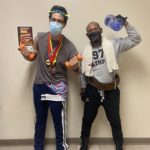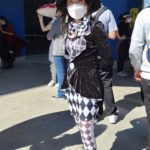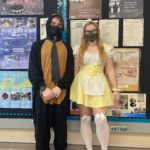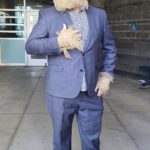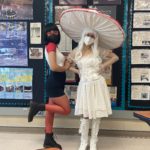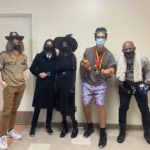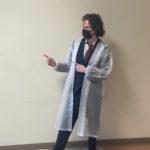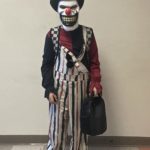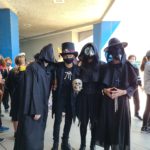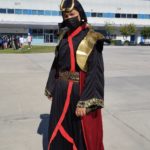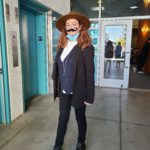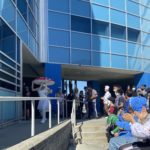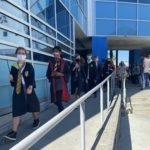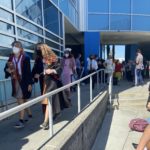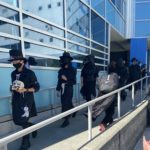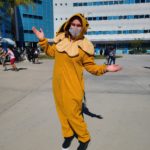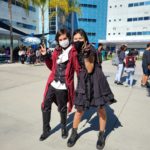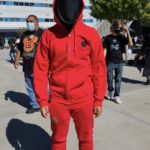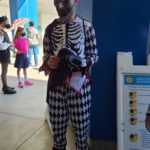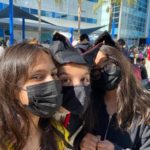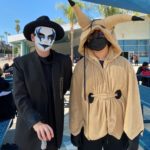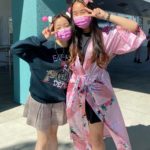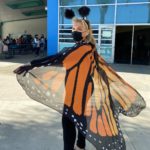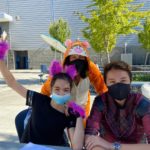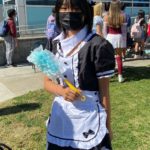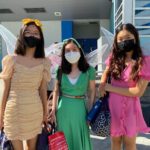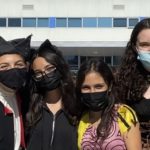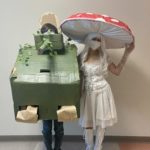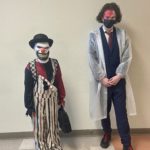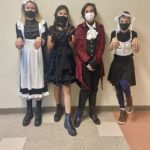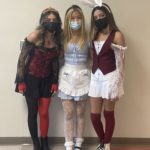
Aviation Club
by Ryan Park
The Aviation Club is a new club formed this year that helps to educate members around aspects of the field of aviation and to teach its members the mechanics and engineering behind aviation. It was founded by Aviation Club president, Solomon Sharp, who answered a few questions recently in order to encourage students to join. The club meets every Wednesday after school in Mr. Bradfield’s room, located in W30.
When simulating a version of flight, the Aviation Club uses multiple tools in order to have members experience the closest thing to real flight. They have multiple tools that have been programmed to act like the real tools you would find in an aircraft such as the yoke, also known as the control stick. The yoke is used in order to control the movement of the aircraft inside the simulators.
What is the purpose of your club?
The Aviation Club is based on educating our members about all aspects of aviation as a whole and teaching them how to use flight simulation technology. As the world is in high demand for pilots and engineers, having knowledge and experience in the field is an important foundation when choosing a career related to aviation. Being involved with aircraft requires many different skills, many of which are applicable to everyday life, and none are exclusive to a specific field. When I started my training as a pilot several years ago, I realized how much I wanted to share this world with other people wanting to take that first step, and how beneficial it could be to their lives.
What is some background info about your club?
A technical and mechanical understanding of aircraft, such as understanding the science of how a vehicle flies and what comes with it, is important not only for engineers but for pilots as well. Flying requires a fundamental understanding of the machine you are commanding and by having that understanding, you can be that much more effective. Aerodynamics, engine mechanics, electronics, and more all go beyond aviation and can be applied in many different fields. One of the most important skills in the world of aviation, though, is of teamwork. Every pilot, engineer, and mechanic all work in conjunction with one another, and none can work with a missing link.
What are some major projects you plan on releasing?
This year, one of our goals is to get everyone hands-on experience with real aircraft, both for maintaining them and flying them. We have already formed strong connections with professional aviators, and the date is currently being coordinated for these goals to be achieved. We are also shooting for designing a remote control model for a plane/drone and constructing it to demonstrate the effectiveness of our design.
What would you say to people interested in your club?
To anyone who is interested in the club, feel free to come and check it out! If you want to see what we’re up to, come to Mr. Bradfield’s room on Wednesdays after school and you might catch us on the simulators. We would love to have new members, and if anyone is interested in joining, come and let me know!


 Club pictures
Club pictures
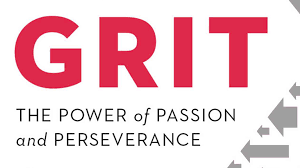
Grit STEM Talk
by Ryan Park
The SciFi Parents sponsored our first in-person STEM Talk of the school year in December with Joshua Spitzen, a man familiar with the concept of success. Having graduated Phi Beta Kappa from Pomona College with a focus in Mathematical Economics, Josh was always on a path of betterment. After graduating from Pomona, he became an investment banker with Patricof and Co. in New York City, helping to manage several mergers and acquisitions. Josh later followed his passion for fitness, serving as an executive with Equinox Fitness Clubs where he honed his leadership acumen. Eventually, Mr. Spitzen joined one of the nation’s largest real estate companies, Keller Williams, with high ambitions for a career with the company. Over time, Josh Spitzen honed his leadership skills and was chosen as C.E.O. of KW’s Beverly Hills offices. Josh now personally oversees and manages close to 1000 agents, and 20 staff members in four Keller Williams offices – culminating in a powerful network of global reach and authentic partnerships.

In addition, Josh volunteers his time to offer his motivational skills in order to help students maximize their potential. He is a big believer in the concept of Grit as outlined by Angela Duckworth in her book Grit: The Power of Passion and Perseverance. He believes that the resilience that comes from developing Grit can go a long way towards helping students persevere on their pathways to success. The five core ideas of Grit are Beast, Effort Counts, Gritty Passion, Grow Grit, and Wise Parents. He shared the video linked below, by Brian Johnson, which goes into more detail on these components and helps students learn how to incorporate these elements into their lives:
https://youtu.be/TF4fUK5KQ0o
In addition, like many people, Mr. Spitzen is a big believer in affirmations: daily statements that help you visualize a desired outcome. At the culmination of the STEM Talk, Josh led the school in his series of affirmations:
I prosper wherever I turn because…
- I am in control of my destiny and I choose to succeed.
- I choose love, joy, and freedom.
- I am brave and fearless. I embrace fear and let it propel my growth.
- I deserve to be happy, healthy and wealthy.
- I have many reasons to be grateful.
- I have a growth-mindset.
- I embrace the process.
- I am changing and I am improving every day.
- I achieve my goals.
- I believe in myself and so do others.
- I am decisive.
- I am healthy and fit.
- I take responsibility for creating my life.
- I am intelligent and kind.
- I project an image of power and confidence.
- I ask for help when I need it. Asking for help is a sign of strength.
- None of us is as smart as all of us.
- I help others become successful.
- Together we all accomplish more.
As Josh stated, talent attracts talent and environment matters. Hopefully, his advice can help you create the right environment to realize your talents!
Read More
Congratulations our new ASB Officers!
High School ASB:
President: Melissa Mouchamel (12th)
Vice President: Scott Oberholtzer (12th)
Secretary: Rachel Lee (12th)
Treasurer: Gautam Gupta (12th)
Historian: Emily Corona (12th)
Middle School ASB:
President: Andrew Bao (8th)
Vice President: Jasper Mejia (8th)
Secretary: Katlia Sherman (8th)
Treasurer: Naira Badalyan (7th)
Historian: Julia Shin (8th)
Class Representatives:
12th Grade: Michael Marenge, Ryan Dowling
11th Grade: Zach Read, Mary Sarukhanyan
10th Grade: Zahra Reaves, Natalie Epshstein
9th Grade: Zachary Miller, Katie Shin
8th Grade: Alex Rostomyan, Hailey Choi
7th Grade: Erin Youn, Ethan De Guzman, Xander Kromnick
6th Grade: Irene Lee, Eric Chung
Statement from Melissa Mouchamel, ASB High School President: I am incredibly excited to take on the role of President this year. Last year was a  difficult challenge for all students; our completely virtual learning environment was far from ideal. I look forward to taking advantage of the return to in-person learning in order to make all of the events we couldn’t have before come to life. So far, all of our Science Academy officers and representatives have worked to organize clubs more efficiently, host several events such as a Spirit Week and our Middle School and High School dances, and more. These events are only the beginning of our journey. I hope to implement more creative contests, fundraisers, Spirit Days, and ultimately a Talent Show for students to showcase their unique skills. As I continue my third year as a part of ASB, I am prepared to use the knowledge I have gained to represent the voices of the Science Academy’s student body to the best of my ability. At the end of the day, the most important part of my position is making sure that the unique voices of our students are heard. I am grateful for this opportunity and will do everything in my power to not only fulfill this responsibility, but to make this a memorable school year for everyone.
difficult challenge for all students; our completely virtual learning environment was far from ideal. I look forward to taking advantage of the return to in-person learning in order to make all of the events we couldn’t have before come to life. So far, all of our Science Academy officers and representatives have worked to organize clubs more efficiently, host several events such as a Spirit Week and our Middle School and High School dances, and more. These events are only the beginning of our journey. I hope to implement more creative contests, fundraisers, Spirit Days, and ultimately a Talent Show for students to showcase their unique skills. As I continue my third year as a part of ASB, I am prepared to use the knowledge I have gained to represent the voices of the Science Academy’s student body to the best of my ability. At the end of the day, the most important part of my position is making sure that the unique voices of our students are heard. I am grateful for this opportunity and will do everything in my power to not only fulfill this responsibility, but to make this a memorable school year for everyone.
Statement from Scott Oberholtzer, ASB High School Vice President: As Vice President, my largest responsibility is in the field of clubs, working alongside Ms. Kincaid and our Club Manager, Gautam Gupta, to process club applications and approvals, along with holding Club Rush to inform students about all of the new and continuing clubs we have available. We have more events and changes planned for the future to make everything about clubs as simple and streamlined as possible both for club members and organizers.
alongside Ms. Kincaid and our Club Manager, Gautam Gupta, to process club applications and approvals, along with holding Club Rush to inform students about all of the new and continuing clubs we have available. We have more events and changes planned for the future to make everything about clubs as simple and streamlined as possible both for club members and organizers.
Being a member of the Associative Student Body, a large part of my job is sufficiently representing the students of Science Academy High School. I know that every decision I make is on behalf of the entire school, and as such, I am working first and foremost on behalf of the students. Everything I have done in my term so far has been with the wants and needs of the students at the forefront, and I will be keeping this as a constant throughout the year. I look forward to continuing assisting the school in whatever way I can and being the best Vice President I can be.
 Statement from Andrew Bao, ASB Middle School President: Hello everyone! I would like to congratulate all of the elected officers, I look forward to serving as the Science Academy Middle School President and to work together as a team to represent this school. Also, thank you to everyone who voted for me – I’ll do my best to make this year as good as possible coming back from COVID. Also keeping my promise, if anyone has any concerns, opinions, or suggestions, please let me know! I’ll be happy to listen and take everything into consideration. After all, getting feedback can help us improve the student body.
Statement from Andrew Bao, ASB Middle School President: Hello everyone! I would like to congratulate all of the elected officers, I look forward to serving as the Science Academy Middle School President and to work together as a team to represent this school. Also, thank you to everyone who voted for me – I’ll do my best to make this year as good as possible coming back from COVID. Also keeping my promise, if anyone has any concerns, opinions, or suggestions, please let me know! I’ll be happy to listen and take everything into consideration. After all, getting feedback can help us improve the student body.
Statement from Jasper Mejia, ASB Middle School Vice President: My goal as Vice President for the Middle School is to help re-connect our middle school student body and build our school community by planning fun activities for all middle school students. I also want to be the voice for students, listening to their suggestions and using those suggestions to create a positive school environment. This year will be full of fun memories!
student body and build our school community by planning fun activities for all middle school students. I also want to be the voice for students, listening to their suggestions and using those suggestions to create a positive school environment. This year will be full of fun memories!
Read More
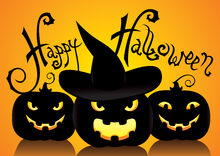
Spooky Supernovas
Halloween was a blast this year! It was so fun to be able to “scare up” some costumes and gather in person to horrify and delight our school community – thank you to everyone who participated!
Congratulations to our Costume Contest winners:
Most Creative:
Middle school – Tank: Jedrek V.
High school – Mushroom: Leah R.
Scariest:
Middle school – Scary clown: Arsen A.
High school – Patrick Bateman from American Psycho: Cormac C.
Best Group Costume:
Middle school – Victorian Servants: Ever P., Tristan C., Lily K., Jack H.
High school – Alice in Wonderland: Kimi P., Natalie M., Chloe M.
(click on the photos in the gallery below to enlarge)
Photo Credits: Emily Corona, Julia Shin, Milan Riley, Jordin Lim
Read More
Día de Los Muertos/Day of The Dead
The LatinX Student Union
Día de Los Muertos
Día de Los Muertos/Day of the Dead is celebrated yearly on November 1st and 2nd. The purpose of the holiday is to remember loved ones who have passed away. On Día de Los Muertos, families visit graves, make food that their departed loved ones once enjoyed, and create altars called ofrendas. Traditional components of the ofrenda are photographs, food offerings, mementos, candles, and orange flowers called cempasuchil (marigold) to decorate the altar and the gravesite.

To celebrate this holiday, the LatinX Student Union put up a traditional ofrenda in the main hallway on the 3rd floor. The ofrenda featured important Hispanic figures, such as Frida Kahlo, Selena Quintanilla, Evangelina Villegas, and Antonio Aguilar. Frida Kahlo was a surrealist Mexican painter who is known for her self-portraits. Selena Quintanilla was a Mexican-American musical artist and is known as the “Queen of Tejano Music.” Evangelina Villegas was a biochemist and was critical to the development of high-quality protein maize. Lastly, Antonio Aguilar is a widely recognized Mexican singer.

The LatinX Student Union also held a fundraiser by selling traditional Mexican candy and pastries. Thank you to everyone who stopped by!
Read More

Homecoming Week
Our Homecoming Experience
by Daniel Svediani and Rachel Nave
Believed to have originated sometime in the 19th century, Homecoming is the tradition of welcoming back students to the new school year. Usually, it celebrates the first home football game of the season and traditionally, a dance is held afterwards. On Saturday, October 23rd, we celebrated our own joint Homecoming with East Valley High School.
On the day of the Homecoming football game, we had a pep rally, held during the high school students’ extended lunch. Students were able to enjoy a routine performed by the school’s cheerleaders, an introduction of the football team, and a presentation of the candidates for Homecoming Court. That same evening, our Falcons participated in a football match against Animo Robinson’s Monarchs. Although our team fought valiantly against the enemy, misfortune befell them and they were crushed by overwhelming odds. However, spirits were lifted during the halftime show. An ensemble of decorated trucks and cars paraded through the field, displaying various other sports teams, advertising our school’s diverse clubs and student body, and culminating in the winners of the homecoming court election. After the festively decorated vehicles circled the football field, the football game continued. (see photos below)
Homecoming Court Winners:
Freshman
Lady: Ava Soh
Knight: Daniel Svediani
Sophomores
Duchess: Gillian Nail
Duke: Zahra Reaves
Juniors
Princess: Michelle DuPont
Prince: Mia Dalbotten
Seniors
Queen: Leah Rosenthal
King: Harry Ilanyan
The next day, the Homecoming Dance provided the students with another opportunity to bolster their school pride, as well as the chance to enjoy some time with friends. The dance was held in the quad between the cafeteria and the gym in a beautifully decorated area. All the trees were decorated with bright yellow lights, all the tables were covered with a black cloth and adorned with decorations such as flower arrangements, and there were multiple balloon spirals spread throughout the area. On the stairs leading up to the gym, a DJ setup and various light fixtures, including multi-colored lasers, were installed. The students were provided with water, a towering supply of various pizzas, and delicacies such as ice cream and cookies, which could be purchased at the Student Store. As the event was coming to a close, the Homecoming Court winners were announced once more to raucous applause and were called up for a slow dance. As everyone joined in, the DJ played a few more slow songs and everyone dispersed, contented, into the night.
While many students really enjoyed the Homecoming Dance, especially the photo booth–which is, as Desmond Devine stated, “always a cool spot to capture memories”–others had some critiques about the music volume and song selections, as well as the menu offerings. Desmond used their input to craft a handy guide for scoring school events. What do you think?
School Event Grading Rubric
| Music | Food | Entertainment | Decor |
| 3: Good volume, open to suggestions | 3: Variety, not costly, plentifulness | 3: Many unique events, games, and activities | 3: Great |
| 2: A little too loud or quiet, slightly limited | 2: Some choice, costs a bit too much | 2: Some timed events and activities, or ones that require cash | 2: Good |
| 1: Inappropriate volume, not flexible | 1: Few options, expensive, limited quantity | 1: Very few or no activities, or those that are costly | 1: They didn’t even try |

Great Opportunities to Learn About Culture at the Science Academy
by Emily Corona
The Science Academy has some excellent clubs focused on culture to offer the student body, all aiming to create a welcoming and educational environment. The clubs themselves are open to everyone from all backgrounds and are all outstanding learning opportunities. The clubs serve to provide a space to empower students of different cultures, all the while unifying the rest of the student body. Students have the opportunity to attend three different cultural clubs: the LatinX Student Union, the Jewish and Israeli Club, and the Christian Club. Each club offers a helpful insight into their respective cultures with their affable leaders and community members. Students are encouraged to visit these clubs and explore the unique cultures of their peers.
The LatinX Student Union, headed by 11th graders Chloe Montalban, Yedid Vargas, and Natalie Mendez, aims to empower and unite the LatinX community here at the Science Academy. The club is open to all students and is an enriching opportunity to learn about multiple aspects of LatinX culture, which includes the cultures of Mexico, Latin America, South America and Spain, as well as the experiences of Latinos and Latinas in the United States. One such meeting focused on the Mexican holiday Dia de los Muertos, or Day of the Dead. An educational presentation about the holiday was presented to club members, detailing traditions like sugar skull painting and the cultural significance of celebrating the dead. Not only that, but the club also spreads awareness regarding issues the community itself faces in contemporary times. The club itself meets weekly and is sponsored by Ms. Huyler.
The Jewish and Israeli Club is another one of Science Academy’s cultural clubs, teaching the history of Israel and neighboring Arab countries. The club also explores Jewish culture, examining important religious works such as the Torah and the Christian New Testament. Club President Jaden Penhaskashi, an 11th grader and the current Science Academy Student Body President, leads the club in a multitude of different discussions alongside club vice president Gregory Kislik. Founded three years ago, the club was intended to educate the student body on the many similarities and differences between Judaism and various other cultures. Many members of the club aren’t Jewish themselves according to Jaden, as he explained:
“I love the fact that there are so many people in our club who do not identify as Jewish or Israeli, and are simply there to learn and understand another perspective!”
The most recent meeting featured a presentation on the Capitol riots and the role antisemitism played in them, as well as a lesson on the current parliamentary system in Israel. The club meets twice a month, with Ms. Herrera serving as club sponsor, and alternates meetings with the Christian Club.
The Christian Club is represented by Jacob Chow and Melissa Mouchamel. It, too, welcomes students of all faith backgrounds as a venue for sharing perspectives. It provides a safe place to learn about and discuss Christianity through life experiences and study of the Bible, as well as learn about the life and teachings of Jesus. As Jacob and Melissa stated:
“In Christian Club, we aim to be a place where people, both Christian and non-Christian, can learn about and discuss Christianity, Bible stories and lessons, as well as life in general. We work hard to stay open to different viewpoints and interact with our members. Being online has been a challenge, but we tried our best to involve everyone in our meetings and are looking forward to meeting in person next year. This year, we have talked about the stories, misconceptions, and values of Christianity. Having the opportunity to share the principles that are so important in our lives and learn about diverse opinions is the reason why we wanted to lead this club together.”
These cultural clubs are incredible opportunities for all members of the student body to learn about the various different cultures of those on campus. They serve to empower those of their respective culture, all the while providing a welcoming learning environment for others to educate themselves. The Jewish Club presents unique opportunities to learn about both Judaism as a religion and Israeli culture. The LatinX Student Union provides in-depth discussions regarding Latino culture and tradition, as well as insight into issues faced by the Latino and Latina population. The Christian Club provides a forum for exploring the many denominations of Christianity and its rich history. Joining these clubs allows students to learn more about the numerous cultures celebrated throughout the Science Academy student body. The Schoology group join codes can be found in the Club Resources folder in the Student Outreach group.
Read More
ASB Members on Changes They Would Like To See In 2021-2022
By Scott Oberholtzer, Sarah Lane, and Emily Corona
As the year comes to a close once more, we look again to the future to see what is next. The 2020-2021 Science Academy Associated Student Body, though it has made great changes to the school environment, including club sign-ups and adding new events, still has wishes they hope can be addressed by next year’s ASB members.
School president, Jaden Penhauskashi, when asked about what he hopes to see changed in the school, shared this:
“My hope is that next year, it will be much easier to run both spirit events and fundraisers, and that being in person will facilitate much greater participation. I would say that I look the most forward to having certain things we previously took for granted like Mr. Lauchu as Santa Claus or even watching a mock Science Bowl competition! I am confident that no matter the challenges ASB faces next year as our school reverts to in-person, they will rise to the occasion and make the school greater than it ever has been.”
The ASB as a whole is excitedly anticipating the coming fall school year when we can get back to in-person fundraisers and events, and possibly rekindle some former school-wide hits, like the Teachers v. Students Science Bowl and the Pi Day Festivities. Jaden expresses the desire of all members of the ASB and the student body when he explains his wishes to regain some sense of normalcy for school events.
Rachel Lee, ASB secretary, responded that:
“The one thing I would say is having more participation from our grade representatives. There are a few students that give a lot of input, but it would be nice to hear what everyone has to say. I think part of it is to find ways to make it less intimidating for them to share their ideas and hopefully when we go back to school, it would be easier for the ASB officers to communicate with the grade reps!”
Encouraging participation from grade representatives allows for the general student body to better communicate with ASB members, and Rachel highlights this in her statement. Hopefully, with the coming year, representatives will have a larger presence in the ASB while in in-person club meetings. In-person meetings could lessen the intimidation reps seem to face, as described by Rachel, in the virtual meetings.
Vice President Thomas Kim, when discussing upcoming shifts in the student body, mentions that:
“Better communication and leadership skills for both ASB officers and representatives is something that I hope will change for next year’s ASB. Additionally, ASB has to become more independent and more smoothly run by the officers and the representatives; we need to make everything much more elegant and timed, rather than choppy. Lastly, we as ASB need to find a way to make our activities and works more spread across the school, building the school’s culture, and most importantly, a community.”
Thomas’ focus as Vice President largely revolves around club management and creation, a job that requires constant communication with officers, especially the President. As such, he is the first to know when communication is a difficulty, and when intervention needs to be made. Communication issues will hopefully be a topic of resolution for next year’s cabinet, allowing for a smoother and more efficient overall Student Body.
Overall, it appears that the upcoming ASB will have big shoes to fill, as they have many different topics and issues to address within the 2021-2022 cycle of the Student Body. Make sure to vote in all upcoming elections, readers, as you can help to make the right choice for The Science Academy STEM Magnet’s future!
Read More
Science Academy High School Debate Team Closes Out a Successful 1st Year
by Sarah Lane & Scott Oberholtzer
The Science Academy High School speech and debate team has just closed out a very successful first year of competition. The team as a whole prospered in every competition, consistently placing at or near the top, with one student making it all the way to the state competition.
The team engaged in its first novice competition on Halloween, with Sarah Lane, Leila Muney, and Mary Sarukhanyan all placing within the Top 5 for Spontaneous Argumentation, as well as Gregory Kislik placing in 5th for Original Oratorical Speaking. The team was congratulated by the League President, Bobby Lebeda, for their high placements in their first competition.
The second speech competition for the year, and the first advanced speech competition for the team, came on November 19, 2020. Sarah Lane, Nicholas Carone, and Cristiana Phelan all placed within the top 10 in Spontaneous Argumentation. In addition to this, Sarah Lane also placed fourth in Impromptu Speaking.
On January 16, 2021, the team conquered its first-ever debate competition. Multiple students competed in a myriad of team and individual events. Gregory Kislik competed in the Lincoln Douglas debate and earned a superior award, while Leila Muney and Cristiana Phelan competed in the Public Forum debate, also earning a superior award. Parliamentary debate had the most entries from the team, with two teams: Rhonen Harris and Sarah Lane, as well as Nicholas Carone and Leila Muney. Both Parliamentary entries earned superior awards at the open debate competition.
In the spring open speech competition on February 20, 2021, the team had an impressive showing in the Spar and Impromptu events yet again, with Leila Muney, Rhonen Harris, and Xander Ashtrafi all placing within the top 10. Rhonen Harris also placed 6th in the impromptu speaking event at the competition.
The team then entered into the debate state qualifiers, on February 27th. At these qualifiers, Mary Sarukhanyan and Leila Muney made it all the way to the finals in Public Forum debate. The team eventually placed 7th in the event.
The next state qualifying event was for speech on March 19th, 2021. Many competitors from the team went to compete against some of the best speakers in the state, with two students from the Science Academy Team placing in finals. Michelle Dupont placed 7th, just short of qualifying for states in the program Oral Interpretation event, while Sarah Lane placed 6th and qualified for the state competition in Impromptu Speaking.
The CA state competition took place over multiple days, from April 19th to the 25th. Sarah Lane ended up competing over three separate days in Impromptu speaking, eventually making it to the semi-finals for the event. Sarah placed 13th overall out of 50+ state competitors.
Team coach Mr. Brooker, club President Mary Sarukhanyan, and the entire team are extremely proud of their stellar performance this pioneering season. With Mary stating, “I’m astonished at how far our team has come, especially since it was all done through a screen. Mr. Brooker and our team members worked really hard to get here”. Both Mr. Brooker and the team hope to return next year even more successful than the last, sending more competitors to state in both Speech and Debate events.
The team has also expressed a desire for new members, as stated by Mr. Brooker. The team is open to all high schoolers, including current 8th graders who will be starting 9th grade with the Science Academy next year. If you’re interested, please reach out to Mr. Brooker via Schoology message. Hope you will consider joining us!
Read More
Club Spotlight: STEM Clubs
STEM Clubs at the Science Academy STEM Magnet
by Milan R. and Muaz R.
At Science Academy, we have a wide range of clubs, all focusing on a variety of subjects, skills, and potential occupations. In this article, we take a look at three of our STEM-focused clubs: StellarXplorers, the Applied STEAM Club, and Math Counts. Stellar Xplorers and Math Counts are sponsored by our wonderful assistant principal, Mr. Rosenthal, while the Applied STEAM Club is sponsored by Mr. Bradfield and led by fellow students Zygmunt R, Nikita A, and Oliver P. All of these clubs feature the use of many different skills in science, technology, engineering, math, and more.
Stellar Xplorers
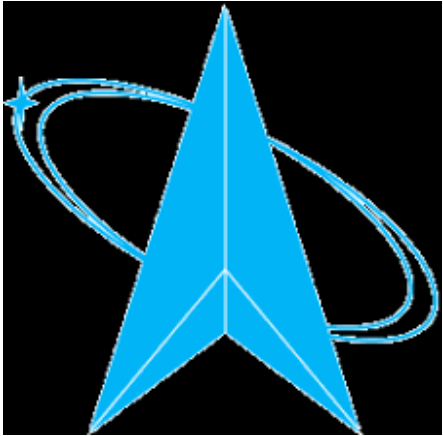 Stellar Xplorers is a high school space-based competition, founded by the National Air Force Association (AFA), that encourages students to use their skills in mathematics, science, and engineering in order to solve real-life problems. Students must grapple through many different computer-generated scenarios, while keeping in mind all the variables that could affect their aircraft, such as launch speed and orbital velocity. Working and familiarizing themselves with these concepts allows pupils to gain a greater advantage when applying these skills to real-life jobs in major organizations and companies such as NASA, JPL, and SpaceX.
Stellar Xplorers is a high school space-based competition, founded by the National Air Force Association (AFA), that encourages students to use their skills in mathematics, science, and engineering in order to solve real-life problems. Students must grapple through many different computer-generated scenarios, while keeping in mind all the variables that could affect their aircraft, such as launch speed and orbital velocity. Working and familiarizing themselves with these concepts allows pupils to gain a greater advantage when applying these skills to real-life jobs in major organizations and companies such as NASA, JPL, and SpaceX.
In order to get a more personal overview of what it’s like participating in the club, we interviewed Zachary M. (8th) on his experiences.
“I first started Stellar Xplorers in the sixth grade. It’s been a great experience so far — Stellar Xplorers has taught me about the different elements of satellite design, weighing the cost-effectiveness of different crucial satellite subsystems, the six classical orbital parameters, and evaluating the data transfer from satellites to satellites and stations, and much more. I would recommend anyone who likes space and is willing to join a team to become a Stellar Xplorer. A lot of Stellar Xplorers is not only about participating in the competitions but also having a good time with your friends. It’s one of the most fun things I’ve done this year and it always gives me something to look forward to. Also, scholarships are given to the top three teams, so that gives an incentive as well. Although you probably couldn’t use the material you learn directly after you participate in a competition when you get older, these competitions can give you some of the necessary knowledge and experience required to be able to work at companies like JPL, NASA, or SpaceX. In my opinion, there is absolutely no prior experience necessary to join this club. I came in knowing nothing about any of the topics I listed prior, but after participating in the competitions and learning about satellites and rockets through this club, I would now consider myself knowledgeable on all of them.”
StellarXplorers explores a wide variety of different topics in STEM fields and allows students to exercise skills that they can apply to real-world careers. If you would like to develop these skills for a present and future occupation, or simply have an interest in what lies beyond the great skies, consider joining Stellar Xplorers! You can do so by emailing Mr. Rosenthal about your interest in the club.
Math Counts
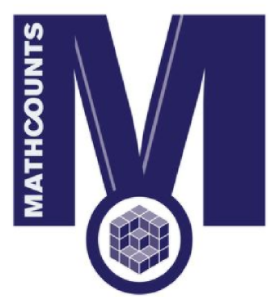 Are you deeply interesting and curious about the mysteries of mathematics and the beauty it encompasses? Or are you simply looking for a way to stretch your brain and increase your critical thinking skills? Math Counts features a solution to both of these problems! Hosted by Mr. Rosenthal, the club grants a way for students to converse and solve math problems with one another as well as increase their logical and critical thinking skills at the same time. Math Counts tackles problems in many different fields of mathematics, including algebra, geometry, probability, and statistics.
Are you deeply interesting and curious about the mysteries of mathematics and the beauty it encompasses? Or are you simply looking for a way to stretch your brain and increase your critical thinking skills? Math Counts features a solution to both of these problems! Hosted by Mr. Rosenthal, the club grants a way for students to converse and solve math problems with one another as well as increase their logical and critical thinking skills at the same time. Math Counts tackles problems in many different fields of mathematics, including algebra, geometry, probability, and statistics.
In order to get a more personal overview of what it’s truly like in the club, we interviewed two club members:
Saket P. (8th): “I first started Math Counts in 6th grade when it was a small group of 6, and we just did math problems and math competitions. We entered competitions like the AMC 8, 10, 12, the Math Olympiad, and the Math Counts and Purple Comet. I would recommend anyone who likes competitive math to come to join, or if you like fun math problems. Most of the stuff you learn can help you gain an advantage in the competition and can help us beat rival schools. I don’t believe there is a need for prior knowledge, you just need to be interested in math. But if you want a list of subjects to prepare for the competition, there are algebra, geometry, number theory, and probability. Math Counts is an amazing club for anyone interested in math. I am excited to see how this club ends up in the years to come.”
Ryan L. (7th): “I first started Math Club just when it was announced by Mr. Rosenthal. The club is a great way to practice skills that you have already learned as well as develop new ones. It’s a great opportunity to have fun with math, and I was able to incorporate the math questions I have answered there with various problems on the AMC and Math Counts. I believe that some prior knowledge is needed, at least algebra. The club is there to learn and practice math. The people who already know the math are able to practice the problems, and more importantly explain how to do the problem to the other students, allowing the other students to learn and allowing all the students to gain more experience in articulating the process and solution.”
Math Counts provides an environment for students to engage in different mathematical challenges and problems with one another in order to expand upon their logical and critical thinking skills. If these activities sound enjoyable to you, consider emailing Mr. Rosenthal about your interest in the club!
Applied STEAM
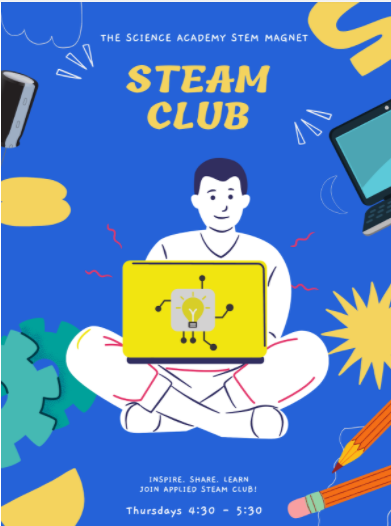 Are you interested in MakerSpace, electronics and/or engineering? If so, you should know the Applied STEAM Club has been devoted to a combination of these topics since they formed in January 2021.
Are you interested in MakerSpace, electronics and/or engineering? If so, you should know the Applied STEAM Club has been devoted to a combination of these topics since they formed in January 2021.
The Applied STEAM Club aspires to be a “community of STEM enthusiasts to showcase cool projects and ideas.” Together, members of the club collaborate on projects and work on them to perfection. Other than collaborating, students “communicate with each other in the STEAM club whether it be through Zoom or Discord”. Their Zoom meetings are every Thursday from 4:30 PM to 5:30 PM.
One of their major goals is to “acquire more members in order to make bigger projects and have better collaborations”. The club representatives are also hopeful the club can meet in person when school returns to normal, and therefore make collaborating easier.
The Applied STEAM Club is sponsored by Mr. Bradfield with Zyg R, Oliver P, and Nikita A as their representatives. To enter the club, students can use the access code from the S.A. Student Body Outreach to join their Schoology group, and they can attend their meetings.
Read More

